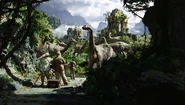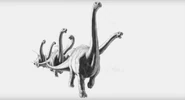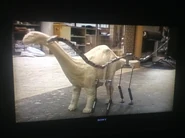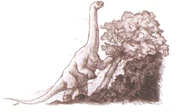| Brontosaurus | |||
|---|---|---|---|
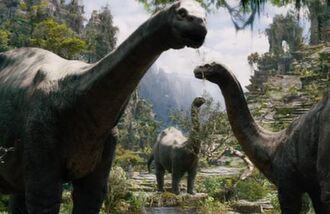
| |||
| Naming | |||
| Binomen | Brontosaurus baxteri | ||
| Morphology | |||
| Body type | Sauropod | ||
| Average height | 20-45 feet tall | ||
| Average length | 80-180 feet long | ||
| Average weight | 50-570 tons | ||
| Intelligence | |||
| Sapience | Non-sapient | ||
| Aggressivity | Very Low | ||
| Ecology | |||
| Place of origin | Earth | ||
| Habitat | Skull Island | ||
| Diet | Herbivore | ||
| Locomotion | Movement using four legs | ||
| Status | Extant | ||
| Behind the Scenes | |||
| Universe | King Kong | ||
| Performed by | Sounds of Elephants, Lions, Tigers, Cattles, Rhinoceros, and Hippopotamus'. | ||
Brontosaurus baxteri ("Baxter's Thunder Lizard") is a huge sauropod native to the fictional Skull Island.
Overview[]
It is the biggest creature on Skull Island and rivals its prehistoric sauropod ancestors in size. Adults can reach lengths of 80-180 feet (24.3-54.5 m), enabling the herbivorous creatures to graze at heights that no other Skull Island plant-eater can even begin to reach. Physically, the creatures are virtually identical to prehistoric sauropods- they have massive, elephantine legs, long necks sporting small heads, and powerful tails used for self defense (although few predators dare to attack fully grown adults).
Unlike prehistoric sauropods, Brontosaurus baxteri give birth to live young that, much like baby mammals, can walk within hours after birth. This, coupled with protection from every older herd member, greatly increases the infants' chances of survival. Because the massive herbivores could easily destroy Skull Island's vegetation and thereby the delicate ecosystem, their numbers are kept in check by a slow reproduction rate. Brontosaurus often create game trails in forests, leaving a path of demolished trees which other herbivores previously held back by the thick vegetation can now pass.
Female Brontosaurus leave the herd when they mature, preventing inbreeding. They join other herds while the males stay to defend the herd. The herds are lead by an adult bull which produces pheromones which stop younger males from reaching (sexual) maturity, making the bull the herd's only reproductive male.
During feeding, the herds often separate. In order to stay in touch with each other, the members communicate by stomping on the ground, producing vibrations which are carried far enough for all members to sense them. Individuals feeding on the outskirts of the herds often serve as sentries, warning the other creatures of predator attacks.
Ironically, the only threat of attack came from an animal much smaller than it - the venatosaur. Rather than strength, Skull island raptors hunted using intelligence. Members of herds would strategically reveal themselves, as seen in the 2005 remake of King Kong, and stampede them down narrow canyons in order to cause critical or fatal injury. Although, in the video game a Vastatosaurus Rex is shown to have killed one of them before it comes hunting for the humans.
Gallery[]
Notes[]
- The design of the brontosaurs were similar to the design by Charles R. Knight and inspired by Ray Harryhausen's brontosaurus from the 1966 film One Million Years B.C..
- The stampede in the 2005 version were particularly inspired by the Mumakil from The Return of the King also directed by Peter Jackson.
- The brontosaur stampede was actually made during the production of a planned 1996 remake.
- The brontosaur that appeared in the 1933 film was depicted as an aggressive aquatic herbivorous creature that chases and attacks the crew like a hippopotamus. Scientists nowadays know that the sauropod was a fully terrestrial herbivore.

